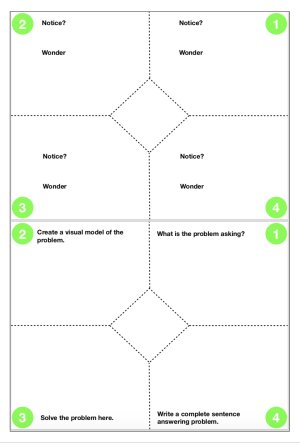Bringing Wonder Into Mathematics
Creatively combining the Notice Wonder strategy with a numberless word problem helps students see themselves as mathematicians.
Your content has been saved!
Go to My Saved Content.Doris Lessing once said, “Any human anywhere will blossom in a hundred unexpected talents and capacities simply by being given the opportunity to do so.”
My wife and I experienced what Lessing described through a process with our third-grade girls as they were struggling with a multiplication math standard (3.OA.4). The girls were getting stuck in a couple of areas regarding the standard, and were developing negative feelings about math and about themselves as mathematicians. We felt some urgency to try something new, and the new thing we tried had to be engaging and fun, and provide ways for the girls to again see themselves as mathematicians.
Lesson 1: A Numberless Word Problem
Although the girls weren’t interested in learning the standard, I knew that if I found the right problem, I could pique their interest. In the California Mathematics Framework for third grade, I found an example problem with both a female lead character and monkeys—we love monkeys. I had found our problem:
For the girls to access our problem, I used the Notice Wonder strategy, which asks a student to address these questions: “What do you notice? And what do you wonder?” A teacher will show a scenario or problem to students, and they answer those two questions (either in writing or in their heads). After a little wait time, students share their answers with a partner, allowing them to hear another’s thinking and to articulate their own observations.
Before the girls engaged in looking at the problem, I needed a few more supports in place, so I modified a foldable sheet known as a diamond paper. To modify it, I added quadrant numbers and a Notice Wonder prompt in each quadrant. On the other side, I numbered the four quadrants and added four prompts. You can see what I did below.

Next I used a numberless word problem approach, in which you take a problem and break it down, first showing students a numberless version and then, one at a time, more complex versions. This process gives all learners multiple repetitions to access the content, calls out important details, and helps students formulate the same question the standard is asking them to solve. Here’s the breakdown for the problem at hand:
- Molly is a zookeeper. She has some hungry monkeys.
- Molly is a zookeeper. She has some hungry monkeys and some bananas.
- Molly is a zookeeper. She has some hungry monkeys and 24 bananas.
- Molly is a zookeeper. She has some hungry monkeys and 24 bananas, and each monkey needs 4 bananas.
One of my daughters read the sentence 1 out loud, and they both wrote their Notice Wonder statements about it. After a few moments, they shared with each other. Then my other daughter read the second sentence, and they wrote their next Notice Wonder statements and shared. Soon all four sentences had been shared. I had the girls write a question they wondered about regarding this situation in the diamond at the center of the paper.
Once the girls had written their questions, I asked them to share with each other. Then they turned their diamond papers over. On the other side, they had to either create a new question, put their questions together to form a bigger question, or choose one of their diamond questions. The girls came up with this new question: How many monkeys is Molly not feeding? They then had four ways to work through the question as they answered it through these four prompts:
- What is the problem asking?
- Create a visual model of the problem.
- Solve the problem.
- Write a complete sentence answering the question.
Lesson 2: Writing an E-book
The girls, like all kids, like to create, so we created an e-book. They helped create a template to use and made a project list to keep track of their tasks:
- Write all the text for the spaces.
- Find and correct all spelling and grammar mistakes.
- Find matching photos for the text, not just fun, funny, or cute pictures.
- They could only add images to the picture boxes in the template.
When they could read the text from cover to cover without finding any mistakes and were happy with their photo choices, we would publish.
Using the numberless word problem and their Notice Wonder statements, they wrote an e-book, Hungry Monkeys, based on their work from Lesson 1, with characters who have a debate about the way to solve the question. They left it for the reader to resolve the conflict in the story.
As Lessing said, the girls blossomed in a hundred unexpected ways: They went from having little understanding to being capable of writing a scenario that showed an understanding of multiple representations of the problem. They had a lot of fun, were fully engaged, and now see themselves as both mathematicians and authors as a result of working through this process. I feel it’s important to share this process so other students will have the opportunity to blossom too.
